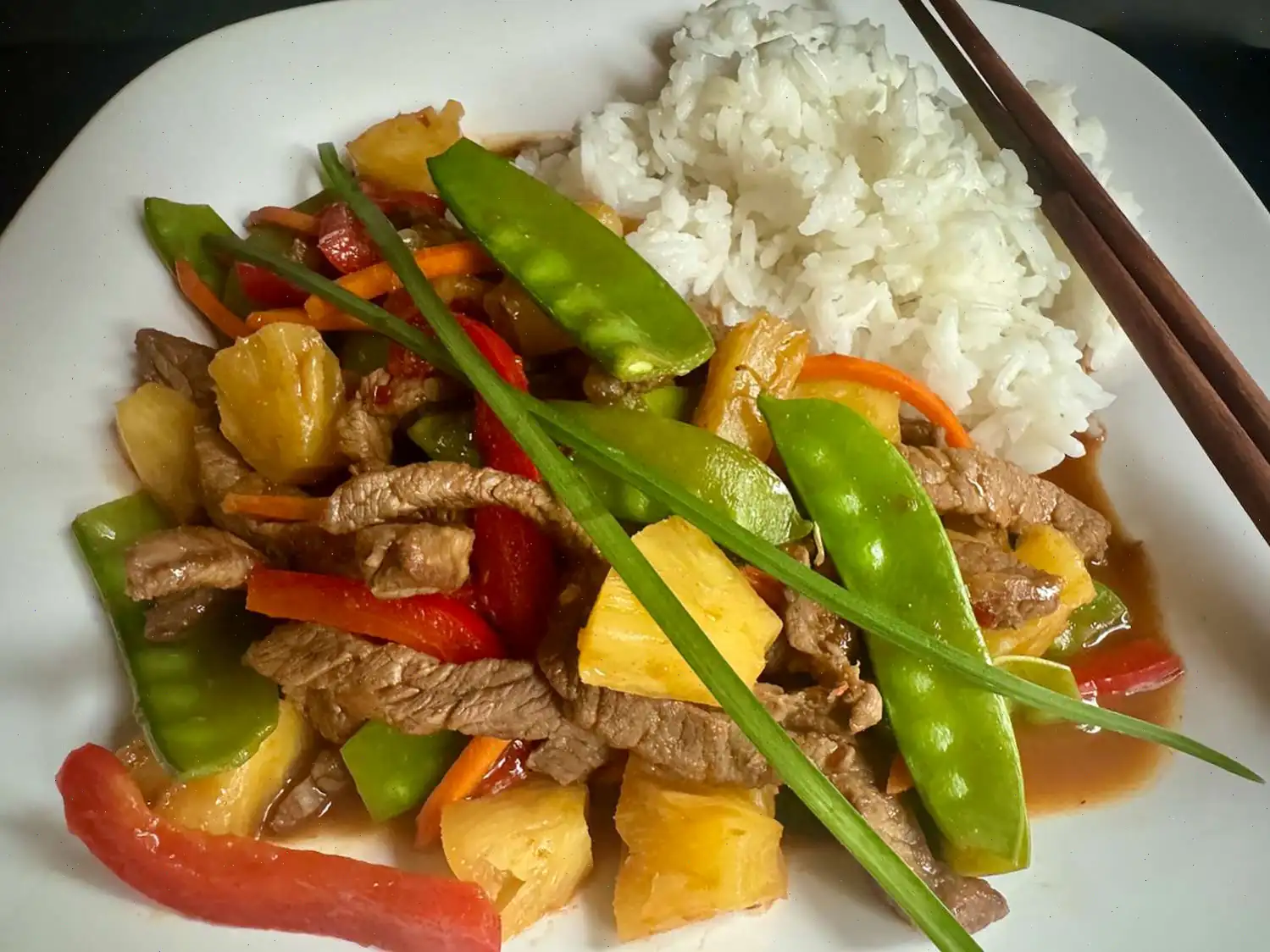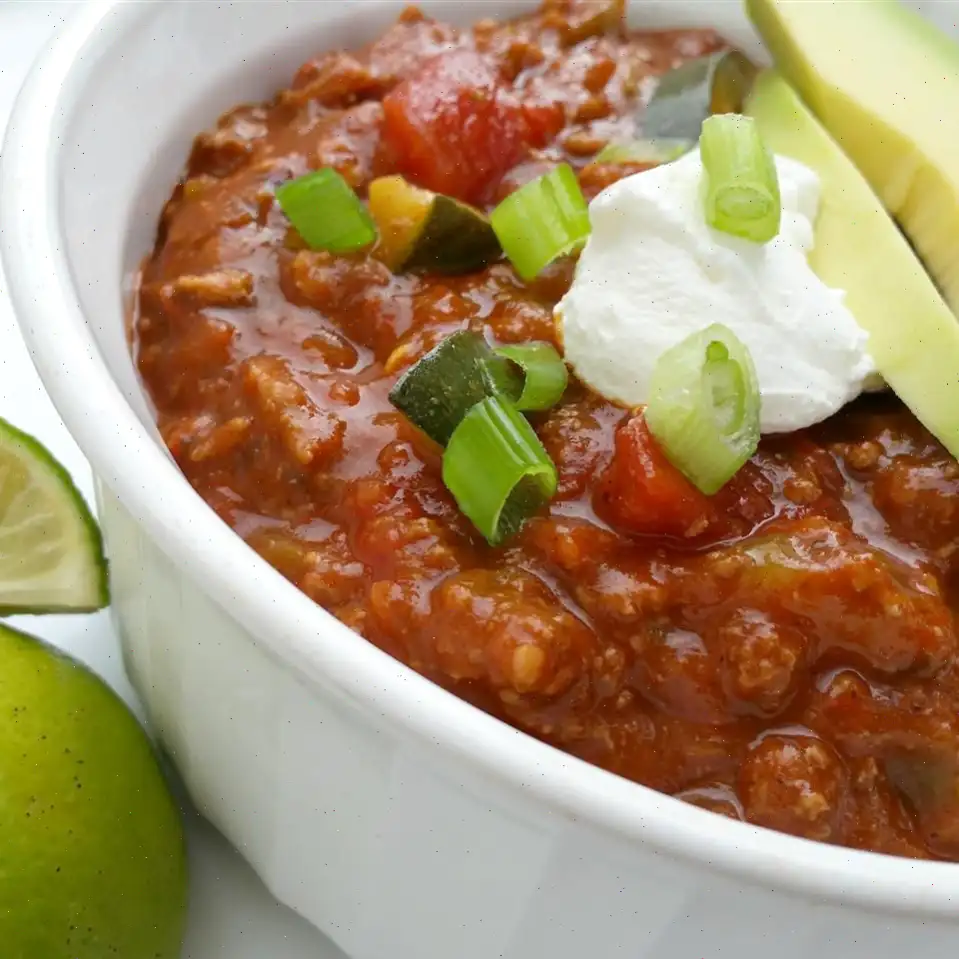
Beef and Pineapple Stir Fry Recipe
Recipe: Beef Stir-Fry with Pineapple
Ingredients
- 1 pound beef top round or top sirloin, thinly sliced
- 1/4 cup cornstarch, divided
- 1 (14-ounce) can pineapple chunks in juice, drained, juice reserved
- 1/2 cup beef broth
- 1/2 cup soy sauce
- 2 tablespoons rice vinegar
- 2 tablespoons sambal oelek or Sriracha, or to taste
- 2 tablespoons vegetable oil
- 1 cup thinly sliced red onion
- 1 cup matchstick-cut carrots
- 7 ounces fresh snow peas, trimmed
- large red bell pepper, thinly sliced
- 2 cloves garlic, minced
- 2 tablespoons grated ginger
- Fresh chopped chives for garnish (optional)
- Hot cooked rice (optional)
Directions
- In a bowl, combine the beef strips and 2 tablespoons of cornstarch. Toss until the beef is evenly coated. Set aside.
- In a separate bowl, mix together 1/4 cup of the reserved pineapple juice, beef broth, soy sauce, rice vinegar, and sambal oelek or Sriracha. Set the sauce aside.
- Heat vegetable oil in a large skillet or wok over medium-high heat.
- Add the beef and sliced onion to the hot oil. Cook, stirring constantly, until the beef is browned (about 5 minutes).
- Add the carrots, snow peas, and red bell pepper to the pan. Stir and cook for about 1 minute.
- Stir in the minced garlic and grated ginger. Cook for another 30 seconds.
- Pour in the reserved sauce and add the pineapple chunks. Stir to combine.
- In a small bowl, mix the remaining cornstarch with 2 tablespoons of water. Add this slurry to the skillet and stir constantly until the sauce thickens (about 1 to 2 minutes).
- Serve immediately over hot cooked rice, garnished with fresh chopped chives, if desired.
Nutrition Facts (per serving)
| Calories | 475 |
| Total Fat | 18g (23% Daily Value) |
| Saturated Fat | 5g (25% Daily Value) |
| Cholesterol | 102mg (34% Daily Value) |
| Sodium | 1964mg (85% Daily Value) |
| Total Carbohydrate | 40g (15% Daily Value) |
| Dietary Fiber | 5g (18% Daily Value) |
| Total Sugars | 22g |
| Protein | 41g (83% Daily Value) |
| Vitamin C | 87mg (97% Daily Value) |
| Calcium | 87mg (7% Daily Value) |
| Iron | 5mg (29% Daily Value) |
| Potassium | 944mg (20% Daily Value) |
* Percent Daily Values are based on a 2,000 calorie diet. Your daily values may be higher or lower depending on your calorie needs.
** Nutrient information is based on available data for this recipe.
The Origins of Beef and Pineapple Stir Fry
Beef and Pineapple Stir Fry is a dish that reflects the fusion of Asian culinary techniques with tropical ingredients. Stir-frying itself originates from China over 2,000 years ago, where quick cooking over high heat was used to preserve the natural flavors and nutrients of fresh ingredients. The addition of pineapple likely emerged from the integration of tropical fruits into Asian cuisines through trade routes in Southeast Asia. This sweet and savory combination became popular for its bold contrast of flavorstender beef with juicy, tangy pineapple.
Regional Variations
While commonly associated with Chinese-style stir-fry, variations of this dish are found across East and Southeast Asia. In the Philippines, a similar recipe may use local vinegar and brown sugar to balance sweetness and acidity, while Thai adaptations often include chili, lime juice, and fish sauce for a spicier, aromatic profile. In Hawaii, beef and pineapple dishes are often grilled, inspired by the fusion of Asian and Polynesian cooking styles. These regional differences highlight the versatility of the core ingredients while maintaining the dishs signature balance of sweet and savory.
Comparison to Similar Dishes
Beef and Pineapple Stir Fry is often compared to the classic Sweet and Sour Beef or General Tsos Chicken. Unlike Sweet and Sour Beef, which typically uses a thicker, tomato-based sauce, this stir fry relies on pineapple juice and soy-based sauce for a lighter, fresher flavor. Compared to General Tsos, which is deep-fried and heavily seasoned with sugar and chili, Beef and Pineapple Stir Fry emphasizes freshness and the natural sweetness of the pineapple, making it less oily and more vibrant in both taste and appearance.
Where Its Usually Served
This dish is a favorite in both home kitchens and casual Asian restaurants worldwide. It is often served over steamed rice or noodles, making it a complete and satisfying meal. In restaurants, it may appear in lunch specials or dinner buffets due to its quick preparation time and appealing presentation. Street food versions, especially in Southeast Asia, sometimes add extra vegetables or local spices, making it a popular choice for a quick, flavorful meal on the go.
Interesting Facts
- Pineapple was first introduced to Asia through Portuguese and Spanish traders in the 16th century, adding tropical sweetness to savory dishes.
- The dish showcases the stir-fry principle of high heat, fast cooking, which helps preserve nutrients while creating a glossy, flavorful sauce.
- Using cornstarch to coat beef and thicken the sauce is a traditional technique in Chinese cooking known as velveting, giving the meat a tender, silky texture.
- While beef is common, variations using chicken, pork, or tofu allow the dish to cater to different dietary preferences without losing its distinctive flavor balance.
- Its colorful combination of red peppers, carrots, green peas, and pineapple makes it visually appealing, aligning with the Asian culinary philosophy that food should please both the eye and the palate.








